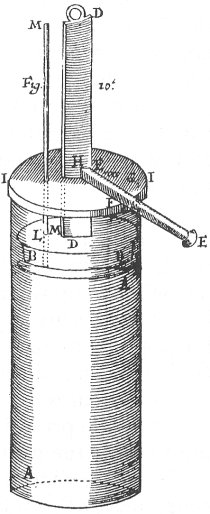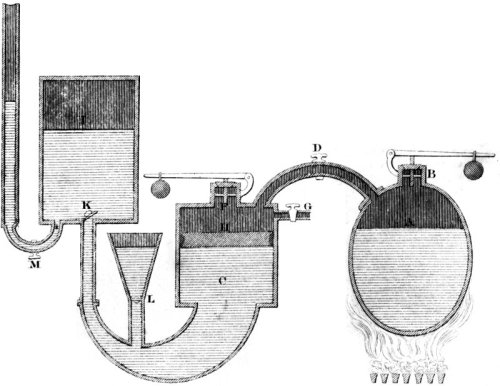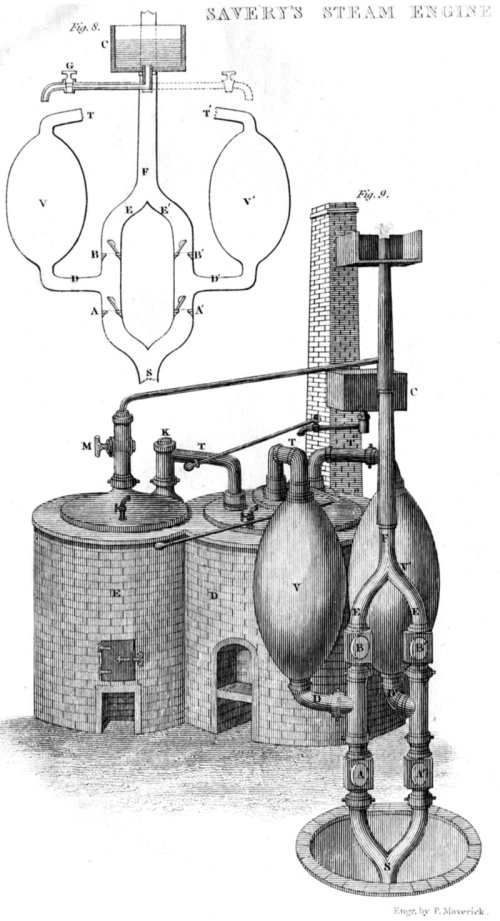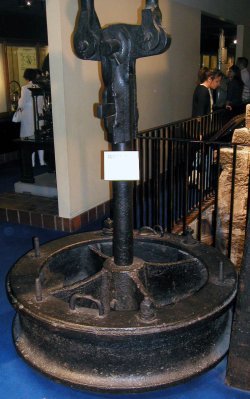Look, up there, on the second story ledge of the Louvre Museum, among statues of great French thinkers -- Descartes, Diderot, Voltaire. One is of a man standing with his left hand resting on a strange device. We have to squint to see what it is. It turns out to be a cylinder, cut away to expose a piston within it. Who is this mechanic in a gallery of intellectuals?
 He is Denis Papin, born in 1647, the same year von Guericke began working with gases. Papin studied medicine, then went to work for Christian Huygens, who was working with air pumps. Papin made a vacuum pump under Huygens's direction. He wanted to use vacuums to preserve food. Later, he invented a high-pressure device for digesting bones for medical studies -- the prototype of the domestic pressure-cooker.
He is Denis Papin, born in 1647, the same year von Guericke began working with gases. Papin studied medicine, then went to work for Christian Huygens, who was working with air pumps. Papin made a vacuum pump under Huygens's direction. He wanted to use vacuums to preserve food. Later, he invented a high-pressure device for digesting bones for medical studies -- the prototype of the domestic pressure-cooker.
Both Huygens and Papin played roles in development of steam engines. And both were French Huguenots. The Huguenots had coexisted with French Catholics since the Edict of Nantes had certified their freedom of religious practice. But, after a rapid buildup of anti-Protestant sentiment, Louis XIV repealed the Edict in 1685.
Four hundred thousand Huguenots were expelled from France. They had to move off into Germany, England, Canada, and other Protestant countries. Many ended up in Massachusetts. Their American progeny included Alexander Hamilton and Paul Revere.
Huygens returned to his native Netherlands and never saw France again. Papin spent the rest of his life in England and Germany. At the University of Marburg, he revisited an idea that Huygens had suggested -- using gunpowder to drive an engine. But Papin soon realized that was impractical. It left a piston full of non-condensable gas after each explosion.

Papin's sketch of his first steam engine.
But if he used steam, it'd condense to almost nothing. Then a piston stroke could be completed. Instead of exploding gunpowder to create pressure, he could condense steam to create a vacuum. Air pressure could drive the working stroke. That turned out to be how the first real steam engines would work.
Papin published the design of such an engine in 1690 -- the one he holds at the Louvre, today. A puddle of water in the cylinder would be alternately boiled and condensed. Boiling filled the cylinder with steam. Work got done when the atmospheric drove the piston downward during condensation.
Keeping the same water in the piston would've made his engine very slow. In practical engines, steam would be introduced from outside, then exhausted either as spent steam or condensed water. Papin reported that heating the water alone would take a full minute. He would've been lucky to get as many as thirty working strokes an hour.
Later, he proposed a more straightforward high-pressure engine. But no one yet knew how to machine a large tight-fitting cylinder and piston. Besides, it was now 1707, and a Devonshire blacksmith, Thomas Newcomen, was finally bringing a useable steam engine into being -- one very like Papin's first engine.
And here the theme of religious rebellion reappears. Newcomen was as much a dissenter as Papin and Huygens. He was an ardent member of one of the emerging Baptist sects. He lived, as Papin had lived, on the other side society's blessing. Perhaps a new thing so radical as the steam engine had to come from the fringes of acceptability.

Papin's final steam engine design. (Notice the pressure relief valves. They were adapted from his earlier bone digester device.)
In Great Britain, the same people shaking off religious orthodoxy also forged a steam-powered economic revolution -- away from London's seats of power. The British Industrial Revolution was largely born in the English countryside, and driven by tradesmen whose beliefs lay far left of the Anglican Church. They forged freedom, not by storming ramparts, but by building Great Britain's new industrial base in their own backyards. They took up textile weaving and new kinds of iron production. They built a network of canals that decentralized the movement of goods. And power would be the key. Steam engines quickly took center stage among those technologies.

Savery's 1699 version of his steam pump, as shown by Lardner.
Another Devonshire inventor had paved the way for Newcomen. Thomas Savery had worked in many technological arenas when, in 1698, he filed his patent for a:
new Invention for Raiseing of Water and occasioning Motion to all Sorts of Mill Work by the Impellent Force of Fire which will be of great vse and Advantage for Drayning Mines, serveing Towns with Water, and for the Working of all Sorts of Mills where they have not the benefit of Water nor constant Windes.
What Savery actually built was a tall hollow pod. Imagine the top first filled with water. Steam, introduced into the pod at high pressure, drives water out the bottom and up a pipe. Then cold water is sprayed into the pod to condense the steam. The resulting vacuum draws water up from a sump below, and the cycle repeats. Savery's patent claims about driving mills and other machines could never've been done with this engine. It had no, piston rod, flywheel, or rocker arm, no means of any kind for driving machinery. It was a one-trick pony; it could only pump water.

Later 18th-century Newcomen-type piston, roughly three feet in diameter with a wide circumferential slot to wind rope as a packing seal. (London Science Museum, photo by JHL)
Steam was to've been supplied at around a hundred pounds per square inch. That would've driven water upward a couple hundred feet. But the steam condensed so rapidly when it hit the cold water, he was lucky to push water twenty feet. His engine never could've done service in a real mine.
Still, Savery actually built a working engine. He publicly demonstrated that steam could pump water. He also telegraphed his engine's potential by naming it The Miners Friend. He left no doubt in anyone's mind that steam would answer the desperately important problem of draining mines, even if his own engine wasn't up to the job.
Right on his heels, Newcomen, and his partner John Calley, began building their engine. By 1712, it was up and running. It was a huge beast. The first one used a cylinder almost two feet in diameter and eight feet high to drive a large external pump. It lifted about 130 English gallons per minute from a mine 150 feet deep. It produced about five and a half horsepower.
And so the steam engine was now a reality. Newcomen's machines sprang up all over England, then Europe. They were so widely used they became a part of natural philosophy instruction. And this is where James Watt finally enters the picture.

Newcomen's atmospheric engine, as it was shown by Lardner.
- P. P. MacLachlan, Papin, Denis. Dictionary of Scientific Biography, Vol. X (C.C. Gilespie, ed.) (New York: Charles Scribner's Sons, 1974).
- Friedrich Klemm gives a nice account of Huygen's and Papin's work on the steam engine in F. Klemm, A History of Western Technology. (tr. Dorothea Waley Singer) (Cambridge, MA: The M.I.T. Press, 1964.) Part Four, The Baroque Period, "The Struggle for a new Prime Mover."
- Papin described his first engines in: D. Papin, Fasciculus dissertationum de novis quibusdam machinis atque aliis argumentis philosophicis quorum seriem versa pagina exhibet. (Marburg: J.J. Kürsnerii, 1695.); and he described his second engine in: D. Papin, Ars nova ad aquam ignis adminiculo efficacissime elevandam. (Frankfort-on-Main, 1707.)
- For many fine illustrations of early steam engines, see: D. Lardner, the Rev., The Steam Engine Familiarly Explained and Illustrated ... (Philadelphia: E. L. Carey & A. Hart, 1836); or and earlier edition: D. Lardner, the Rev., Popular Lectures on the Steam Engine ..." (New York: Elam Bliss, 1828).
- For a very helpful overview of the 18th-century origins of the British Industrial Revolution, see: J. Bronowski, The Ascent of Man. (Boston: Little, Brown and Company, 1973): Chapter 8, The Drive for Power.
- Two good general sources on the history of steam engines also include specific material about Savery's engine. They are: H. W. Dickinson, A Short History of the Steam Engine. (Cambridge: At the University Press, 1939): Chapter 2; and L. T. C. Rolt, Thomas Newcomen: The Prehistory of the Steam Engine. (Plymouth: Latimer Trend & Co. 1939): Chapter 1.